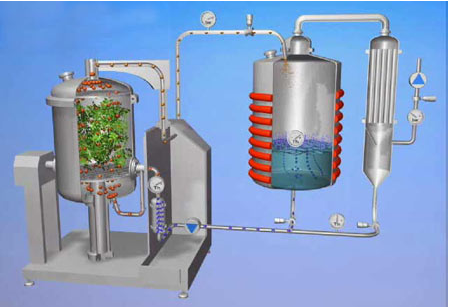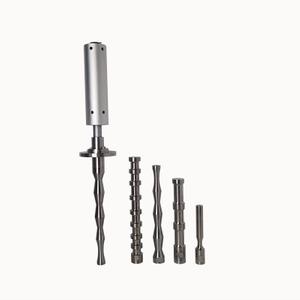As early as the 1950s, ultrasonic waves were used to extract bitterin from peanut oil and hops, fish oil in fish tissues, and the like. At present, ultrasonic extraction technology has been widely used in the separation and extraction of organic or inorganic components in foods, pharmaceuticals, industrial raw materials, agricultural environments and other samples.

First, the application in the food industry
In the food industry, ultrasonic extraction technology is a marginal and cross-disciplinary technology that has attracted widespread attention from many national science and technology workers.
1. Grease leaching
Enhanced extraction of oil from the ultrasonic field can significantly improve the leaching efficiency, improve the quality of the oil, save raw materials, and increase the amount of oil extracted.
At present, the extraction of cod liver oil is mainly carried out by a dissolution method, and the oil yield is low, and the high temperature causes the vitamin to be destroyed. Ultrasound can also be used for the processing and extraction of animal oils, such as the extraction of cod liver oil. Soviet scholars used 300, 600, 800, and 1500 kHz ultrasonic waves to extract cod liver oil, which could extract almost all the oil in the tissue within 2 to 5 minutes. The vitamins contained in the tissue were not destroyed, and the oil quality was superior to the traditional method.
2, protein extraction
Ultrasonic extraction of protein also has a significant effect. For example, the extraction of soy protein from the treated defatted soybean embryo by conventional stirring method can rarely reach 30% of the total protein content, and it is difficult to extract the heat-labile 7S protein component. However, ultrasonic waves can be used to pulverize the above-mentioned embryos in water, liquefy 80% of the protein, and extract heat-labile 7S protein components.
Some scholars have carried out a series of tests on ultrasonic treatment of different concentrations of soybean slurry, pre-milled heat-treated soybean slurry and the separated bean dregs. The results showed that the ultrasonic content of the soymilk was significantly improved in the soy milk compared with the untreated, and the increase ranged from 12% to 20%, indicating that the ultrasonic treatment did improve the protein extraction rate. The role.
Ultrasonic treatment can also increase the separation temperature of the slurry and reduce the viscosity of the slurry. It can be used to directly produce high concentration (high protein) soy milk products.
3. Polysaccharide extraction
Some scholars used white peony tubers as raw materials to extract crude polysaccharides from Radix Paeoniae Alba. Compared with various extraction methods, ultrasonic treatment at room temperature is the most ideal extraction method. The extraction of polysaccharides from Flammulina velutipes fruit body was enhanced by ultrasound, which increased the extraction rate of polysaccharide by 76.22%.
Some scholars have used ultrasonic hot water to extract polysaccharides from Tremella fuciformis, and the extraction rate is 5% higher than that of enzymatic method, and the extraction time is greatly shortened. Some scholars have systematically studied the mechanism, optimization scheme and composition and structure of the polysaccharides extracted by ultrasonic catalytic enzyme method, and also studied the extraction of Cordyceps polysaccharide, lentinan and Hericium polysaccharides. Compared with the process, the ultrasonic enhanced extraction operation is simple, the extraction rate is high, and no material loss or side reaction occurs during the reaction process.
Some scholars have studied the extraction of seaweed polysaccharides by circulating airlift ultrasonically disrupted S. cerevisiae. It is found that the ultrasonic extraction at room temperature for 20 min can reach the extraction rate of polysaccharides at 100 °C for 4 h, which is significantly higher than that at 80 °C for 4 h. Ultrasonic extraction was also confirmed to be an effective enhanced extraction method by comparing the polysaccharides extracted from Salviaofficinalis L with ultrasound and without ultrasound.
4, natural spice extraction
Some scholars have used ultrasound to enhance supercritical fluid extraction (SSFE) capsaicin in pepper, and achieved good results.
Some scholars have used ultrasound to extract the natural flavor of broadleaf sedge. In the test, they compared the results of ultrasonic extraction with no ultrasonic extraction. The results show that the filtrate on the ultrasonic wave and the absorbance of the luminosity are 12% higher than the absorbance of the filtrate without ultrasonic. ~40%, indicating that the ultrasonic wave has a significant effect on the extraction rate.
It has been reported in the literature that extracting orange peel essential oil from orange peel and using dichloromethane as solvent, the extraction rate of essential oil extracted by ultrasonic wave at 20 kHz for 10 min is 2 times higher than that of steam distillation for 2 h and Soxhlet extraction for 2 h.
5. Application in food analysis
Ultrasonic extraction is also used for the pretreatment of food samples. The national standard (GB5009.696) acid hydrolysis method for determining the fat content of lunch meat is cumbersome to operate, and the influence of human factors is large, which is difficult to grasp.
Some scholars have used ultrasonic to improve the fat content of lunch meat by acid hydrolysis. Ultrasonic extraction of samples does not require heating, which shortens the digestion time of samples, and can simultaneously determine the fat content of large samples.
Some scholars use ultrasonic to extract cyclamate in food, and can process dozens of samples at a time, which is easy to operate, and the precision and accuracy meet the requirements.
Some scholars combined the ultrasonic extraction test conditions of soy isoflavones to determine the samples by HPLC method, shortened the pretreatment time of soybean isoflavones by HPLC method, improved the extraction rate of soybean isoflavones, and established a more complete HPLC method. Pretreatment and chromatographic conditions of soy isoflavones.

Second, the application of natural plant and pharmaceutical active ingredients extraction
The extraction speed of ultrasonic extraction technology and the quality of the extracted product make this technology a powerful tool for the extraction of natural products and biologically active ingredients. In particular, the extraction of biologically active ingredients, such as the toxicity of animal tissue serum, the extraction of vitamin A, vitamin D and vitamin E in the feed.
Because the extraction methods commonly used in natural products and active ingredients have the disadvantages of large loss of active ingredients, long cycle, and low extraction rate, ultrasonic extraction can shorten the extraction time, increase the rate of active ingredients and the utilization rate of the medicinal materials, and avoid high temperature. Extract the effects of ingredients.
India, the United States, the former Soviet Union and other countries have carried out ultrasonic extraction research on medicinal plants such as plant pepper leaves and cinchona, and achieved good results. In recent years, domestic progress in this area has made remarkable progress. Guo Xiaowu and Wang Changli et al. summarized the application of ultrasonic extraction technology in the extraction of active ingredients, process selection and content control of Chinese herbal medicine.
Ultrasonic extraction of rutin in glutinous rice and berberine in berberine, compared with the traditional hot alkali boiling extraction method, the extraction rate increased from 12% to 14% to 16% to 22%, and the composition is stable and not destroyed.
Some scholars used ultrasonic technology to extract volatile active constituents from the whole grass, roots, stems and leaves of Bupleurum chinense L. with methanol, diethyl ether and hexane mixed solvent, and carried out high-resolution GC-MS analysis to identify 116 components. Some scholars have applied ultrasonic extraction of Gynostemma pentaphyllum.
Some scholars have separately discussed the ultrasonic vacuum freeze-drying extraction process and the conventional extraction process, and analyzed and compared the active substances contained in the Aloeveral extracted from the two processes. The aloe vera gel preparation prepared by ultrasonic extraction combined with the freeze-drying process has high purity and strong activity. The peroxidase, protein and organic acid are higher than the conventional process, and most of the active ingredients in the aloe gel are retained.
In addition, the active substances extracted by ultrasonic extraction include: Thousand-gold fat oil, total flavonoids of Acer truncatum Bunge, anthocyanin pigment in purple potato, bitterol in tartary buckwheat, bitter ketone and tartrate diol, and active constituents in Eucommia ulmoides leaves , montmorillon yellow pigment, bitter almond oil, chlorogenic acid in ragweed stems. These further prove the advanced and scientific nature of ultrasonic extraction technology, which can be used for the extraction of various effective substances, which provides a useful reference for the application of ultrasonic extraction technology in the food industry.
 English
English





